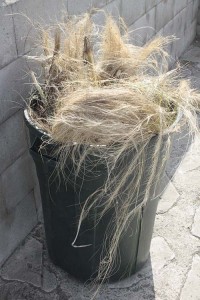This will be the year that I finally win the battle against Mexican feathergrass, the blogger said optimistically. I doubt that I’ll be seeing the end of this beautiful but wildly overprolific grass any time soon, but I’ve completed pulling all the parent plants in the garden. With the source of seeds removed, the hundreds of unwanted seedlings that I have to pull up every year should diminish.
So how bad was the feathergrass problem? Here’s a shot underneath a black sage in the back yard, no closer than seventy-five feet from the nearest adult feathergrass plant capable of setting seed. The seed just blew downwind and set up household in the sheltered germinating conditions in the shade of the sage. Other areas of the garden will look like this when the rains begin again and all the banked seed begins to germinate. I hate to think that these might get to the local urban canyon, four houses away.
My relationship with Mexican feathergrass (Nassella tenuissima or Stipa tenuissima) started off in the early 1990s. Like most people who’ve planted it, I saw it at the nursery with its stalks weaving delicately in its beguiling come-hither way and fell in love. I bought two.
At first things between us went well. The grasses spread a bit, but the thought of free plants were a real bonus. I even gave plants away.
Though prolific, the plant isn’t currently listed as an invasive species on the master Cal-IPA inventory, but appears on a 2007 list of nominated species. It’s clear from some of the comments on a Fresh Dirt posting that it’s a growing problem in some areas, my neighborhood included.
Yes, the stuff is gorgeous. But too high maintenance and potentially problematic in my area. It’s time for us to part ways.
So how will I get my fix for delicate, feathery grasses? This year has been my first time growing the native Aristida purpurea, purple three-awn, a species that’s found locally. The plant is shorter than the common feathergrass, which might be a bonus, depending on your garden situation. And unlike the nassella it has a decidedly purple color to it while it’s growing–very nice. I’ll post photos once my plants get a little bigger. I have no idea if it’ll be the same issue of the plant volunteering all over the garden, though I doubt it. Even if it escapes to the wilds, it’ll be in the company of others of its species. Not a problem.



